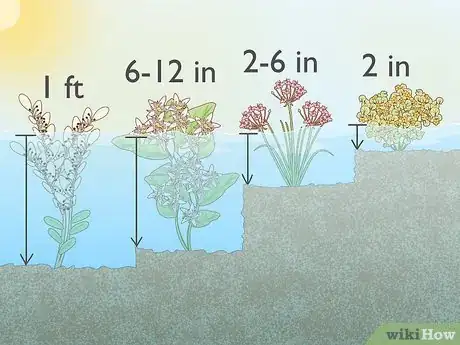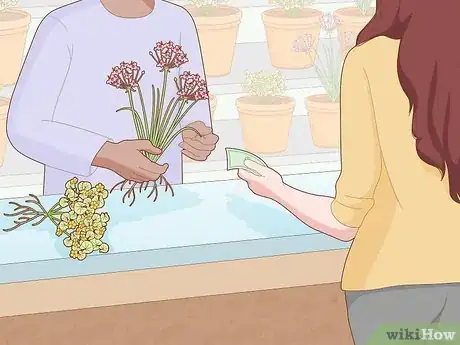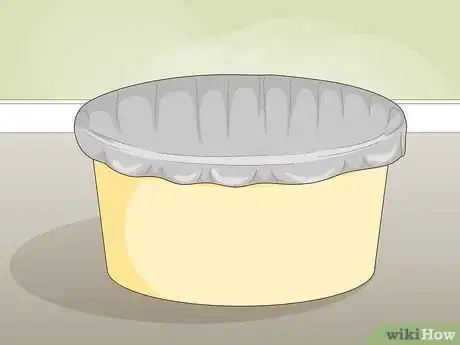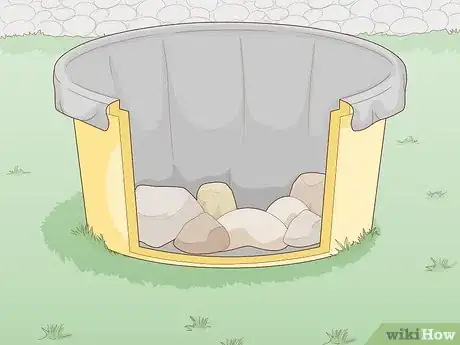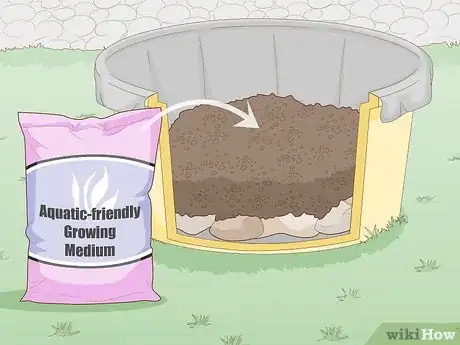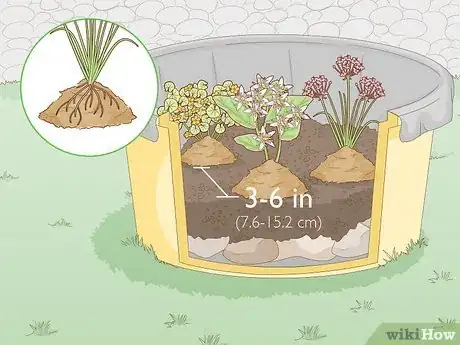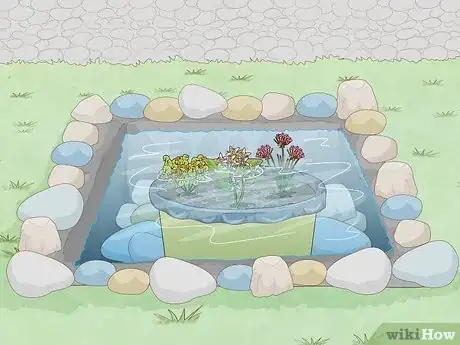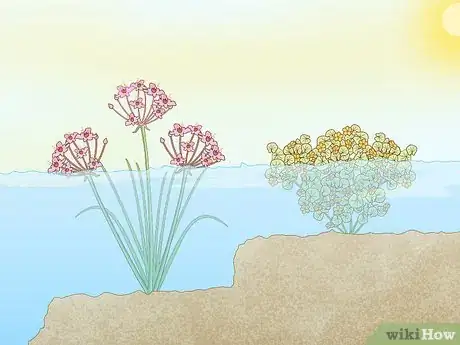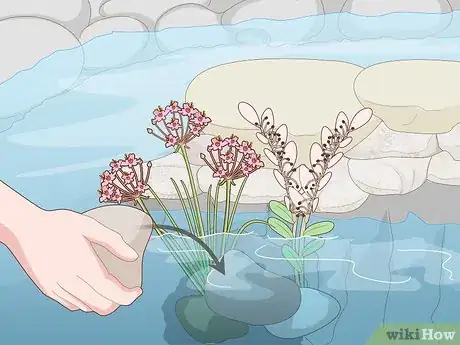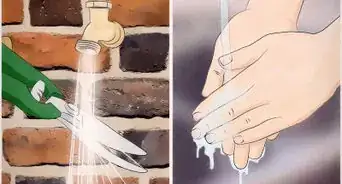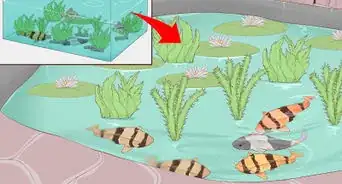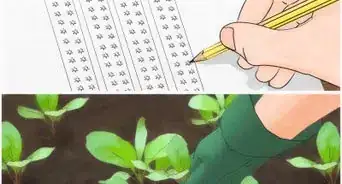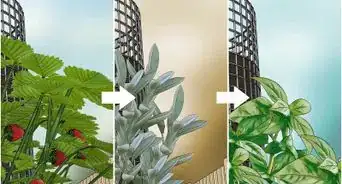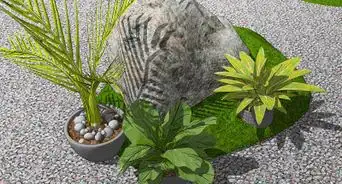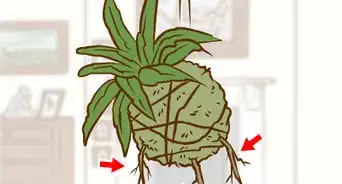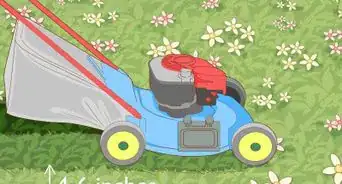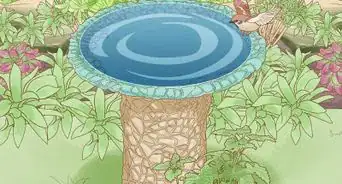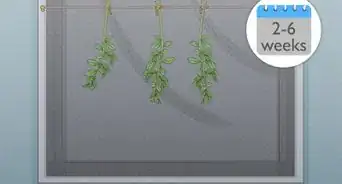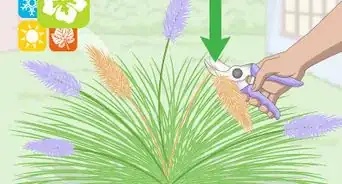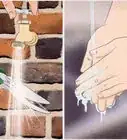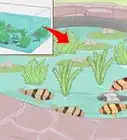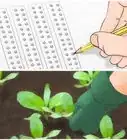This article was co-authored by Mike Garcia. Mike Garcia is a Licensed Landscape Contractor and the Founder of Enviroscape LA, a full-service landscape design and construction firm in Los Angeles, California. With over 30 years of experience, Mike specializes in sustainable landscape practices. Mike holds an Ornamental Horticulture degree, C-27 Landscape Contractor and D-49 Tree Service Contractor licenses, and Permaculture Design, California Naturalist, International Certified Professional Pond Contractor, and Pond Building certifications. He is one of eight Internationally Certified Pond Builders in the world. Enviroscape LA has won landscape and water feature awards from the International Professional Pond Contractors Association (IPPCA), National Association of Pond Professionals (NAPP), and the California Landscape Contractors Association (CLCA). Mike is a past president of the CLCA and currently serves on their local Board of Directors. Enviroscape LA has been featured in PONDS USA Magazine, Pond and Garden Lifestyles Magazine, and the Los Angeles Times. Mike has appeared on Extreme Home Makeover, HGTV's Landscapers Challenge, and A & E's series Fix That Yard.
There are 7 references cited in this article, which can be found at the bottom of the page.
This article has been viewed 11,032 times.
Marginal plants are aquatic plants that grow around the edges of ponds. The plants often feature white flowers or colorful leaves to accent the pond. Planting marginals is easy! Just decide if you want to create containers to situate along the margins of your pond, or if you want to plant marginals directly in the water with rocks to hold them in place.
Steps
Planting in Containers
-
1Choose marginal plants based on the water’s depth. Use a ruler or tape measure to measure the depth of the water where you would like to plant potted marginals. Then, select marginals based on the depth of the area you want to plant them. Some example depths and plant options include:[1]
- 1 ft (0.30 m) or deeper: great water plantain or water hawthorne
- 6 to 12 in (15 to 30 cm): bog bean, lesser spearwort, or arum lily
- 2 to 6 in (5.1 to 15.2 cm): sweet flag, flowering rush, bog arum, yellow flag, corkscrew rush, golden club, pickerel weed, and giant water buttercup
- 2 in (5.1 cm) or less: marsh marigold, golden buttons, Japanese water iris, water forget-me-knot, lizard’s tail, and brooklime
-
2Select the aquatic plants you want to grow in a container in your pond. There are many different types of aquatic plants that you can grow in containers submerged in a pond, so visit a plant nursery or garden center to find some that you like. Try pairing a short and a tall plant or 2 plants with different color leaves to add interest to your pond garden.[2]
- Plan to purchase and plant your aquatic plants between mid-spring and early summer.
- Check the tag on the plant to determine if you need to grow more than one, what height the plants will reach, and how far apart to plant them.
Advertisement -
3Choose a container meant for growing aquatic plants. Aquatic plant containers have many small holes in them so that water can easily flow through them. You can purchase these types of containers at a plant nursery or garden center.[3]
- Make sure that the container is big enough to fit all of your plants into it. Do not place more than 3 plants in each container.
- If you don’t want to submerge the pot, you could also place it in a normal pot and position it on the edges of the pond.
Tip: One benefit of growing plants in containers is that they are less likely to spread and become an invasive species in your pond garden. You can also reduce the chances of introducing an invasive species by quarantining any new plants you purchase for 3 weeks before adding them to your pond.[4]
-
4Line the container with hessian or a polypropylene fabric unless it’s made from a fine mesh. Unless the container is made from fine mesh, you’ll also need to line the container with hessian or a polypropylene fabric to prevent soil from escaping. Place 1 layer of the material in the container so it covers all sides. Then, trim the excess material along the rim of the pot.[5]
- You can purchase these types of material at a garden supply store or nursery.
-
5Layer large rocks or stones at the bottom of the container. It’s possible for the planter to tip over or float away if it’s not heavy enough, especially if you’re planting a tall aquatic plant in your container. To help weigh it down, place 7-10 rocks or a single layer of stones in the bottom of the planter.[6]
- You can harvest rocks or stones from in and around your pond or garden.
-
6Fill the container halfway with an aquatic-friendly growing medium. Use your hands or a small garden trowel to do this. Medium to heavy loam is ideal for aquatic plants, but you can also use garden soil as long as it’s free from herbicides and fertilizers. If you’re unsure, get a specially formulated aquatic growing medium, which will help to promote the best results for your aquatic plant.[7]
- Keep in mind that aquatic growing mediums usually contain fertilizer, but it is a special slow-release kind that will not seep out into the pond water.
-
7Add the plants to the container and cover the roots with soil. Take the plants out of the containers they are in and gently pull apart the roots to loosen them. Then, place the plants into the container with about 3 to 6 in (7.6 to 15.2 cm) between them. Scoop more soil into the planter to cover the roots completely.[8]
-
8Cover the soil with a layer of gravel to prevent fish from disturbing it. To finish preparing your plant for the pond, scoop gravel onto the soil to cover it completely. Use about 1 to 2 in (2.5 to 5.1 cm) of gravel to the top of the soil. This will help to prevent fish and other wildlife from kicking up soil when they swim around in the plant.[9]
- You can also layer more stones or rocks on top of the soil if you do not have gravel.
-
9Soak the planter in water for 5 minutes. Pre-soaking the planter will help to weigh it down and rinse off any loose soil or debris before you introduce it. Place the planter in a bucket or sink filled about 1/2 to 2/3 full with water. Then, remove it from the sink and place it on the ground to drain.[10]
- Don’t do this inside. Make sure to soak and drain the planter outside to avoid making a mess.
-
10Submerge the planter in the pond at the edge or in a shallow area. Choose an area of the pond that is deep enough to cover the planter with the plant above the surface of the water. Or, if you used a normal planter, you could position the pot along the edges of the pond.[11]
- Try placing a few rocks around the sides of the pot to help keep it in place.
Situating Plants Directly in the Pond
-
1Choose marginal plants based on the depth of the water in your pond. Measure the depth of the water where you would like to plant marginals. Then, select marginal based on the depth of the area you want to plant in. Some example depths and plant options include:[12]
- 1 ft (0.30 m) or deeper: great water plantain or water hawthorne
- 6 to 12 in (15 to 30 cm): bog bean, lesser spearwort, or arum lily
- 2 to 6 in (5.1 to 15.2 cm): sweet flag, flowering rush, bog arum, yellow flag, corkscrew rush, golden club, pickerel weed, and giant water buttercup
- 2 in (5.1 cm) or less: marsh marigold, golden buttons, Japanese water iris, water forget-me-knot, lizard’s tail, and brooklime
-
2Remove the plant from the container it came in and rinse its roots. Use your fingers to gently spread the roots apart, which is also known as tickling the roots. Then, rinse the roots under running water to remove the excess dirt. Use an outdoor spigot or garden hose to do this.[13]
- Make sure to check the plant’s tag for information about how tall the plant will get, how far apart to plant it from other plants, and other important information.
Warning: Do not rinse the roots over an indoor sink as the soil may clog your drain.
-
3Move rocks to make a space for the plant at the edge of the pond. Choose where you want to place the plants, then move a few large rocks aside to make a space for them. Place the rocks on the grass nearby while you plant the marginal.[14]
- Try not to unsettle any of the dirt or sand in this area when you pull out the rocks.
- Another option is to plant the marginal directly in the soil on the edges of the pond. This will integrate them into the pond without submerging the plants in water.
-
4Place the roots of the plant in the water and secure them with rocks.[15] Next, place the marginal into the water roots down so that they are nestled right on top of the soil in the pond. Then, take the rocks you removed and stack them around the plant’s roots to keep it from floating away.[16]
- The rocks will keep the plant in place and the plant will eventually root itself into the soil.
Expert Q&A
-
QuestionHow do I stop my fish from pulling up my plants?
 Mike GarciaMike Garcia is a Licensed Landscape Contractor and the Founder of Enviroscape LA, a full-service landscape design and construction firm in Los Angeles, California. With over 30 years of experience, Mike specializes in sustainable landscape practices. Mike holds an Ornamental Horticulture degree, C-27 Landscape Contractor and D-49 Tree Service Contractor licenses, and Permaculture Design, California Naturalist, International Certified Professional Pond Contractor, and Pond Building certifications. He is one of eight Internationally Certified Pond Builders in the world. Enviroscape LA has won landscape and water feature awards from the International Professional Pond Contractors Association (IPPCA), National Association of Pond Professionals (NAPP), and the California Landscape Contractors Association (CLCA). Mike is a past president of the CLCA and currently serves on their local Board of Directors. Enviroscape LA has been featured in PONDS USA Magazine, Pond and Garden Lifestyles Magazine, and the Los Angeles Times. Mike has appeared on Extreme Home Makeover, HGTV's Landscapers Challenge, and A & E's series Fix That Yard.
Mike GarciaMike Garcia is a Licensed Landscape Contractor and the Founder of Enviroscape LA, a full-service landscape design and construction firm in Los Angeles, California. With over 30 years of experience, Mike specializes in sustainable landscape practices. Mike holds an Ornamental Horticulture degree, C-27 Landscape Contractor and D-49 Tree Service Contractor licenses, and Permaculture Design, California Naturalist, International Certified Professional Pond Contractor, and Pond Building certifications. He is one of eight Internationally Certified Pond Builders in the world. Enviroscape LA has won landscape and water feature awards from the International Professional Pond Contractors Association (IPPCA), National Association of Pond Professionals (NAPP), and the California Landscape Contractors Association (CLCA). Mike is a past president of the CLCA and currently serves on their local Board of Directors. Enviroscape LA has been featured in PONDS USA Magazine, Pond and Garden Lifestyles Magazine, and the Los Angeles Times. Mike has appeared on Extreme Home Makeover, HGTV's Landscapers Challenge, and A & E's series Fix That Yard.
Licensed Landscape Contractor Try placing rocks over the roots of your plant and around the base of the plant. The rocks should hold the plant securely down.
Try placing rocks over the roots of your plant and around the base of the plant. The rocks should hold the plant securely down.
Things You’ll Need
Planting in Containers
- Aquatic plants
- Aquatic plant container
- Hessian or a polypropylene fabric
- Fabric scissors
- Large rocks
- Aquatic growing medium
- Gravel
Situating Plants Directly in the Pond
- Aquatic plants
- Garden hose
- Rocks
References
- ↑ https://www.rhs.org.uk/advice/profile?pid=839
- ↑ https://www.rhs.org.uk/advice/profile?pid=839
- ↑ https://www.rhs.org.uk/advice/profile?PID=448
- ↑ https://www.rhs.org.uk/advice/profile?PID=448
- ↑ https://www.rhs.org.uk/advice/profile?PID=448
- ↑ https://www.rhs.org.uk/advice/profile?PID=448
- ↑ https://www.rhs.org.uk/advice/profile?PID=448
- ↑ https://www.rhs.org.uk/advice/profile?PID=448
- ↑ https://www.rhs.org.uk/advice/profile?PID=448
- ↑ https://www.youtube.com/watch?v=bN-YU7QhTBk&feature=youtu.be&t=130
- ↑ https://www.youtube.com/watch?v=bN-YU7QhTBk&feature=youtu.be&t=130
- ↑ https://www.rhs.org.uk/advice/profile?pid=839
- ↑ https://www.youtube.com/watch?v=bN-YU7QhTBk&feature=youtu.be&t=193
- ↑ https://www.youtube.com/watch?v=bN-YU7QhTBk&feature=youtu.be&t=225
- ↑ Mike Garcia. Licensed Landscape Contractor. Expert Interview. 20 November 2020.
- ↑ https://www.youtube.com/watch?v=bN-YU7QhTBk&feature=youtu.be&t=238
